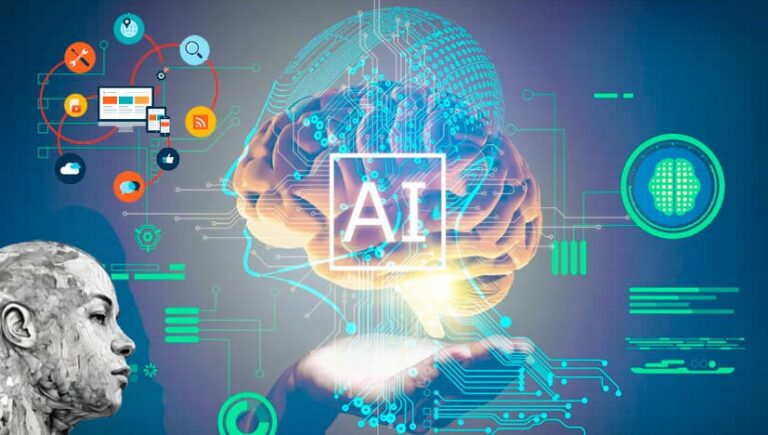The arrival of low-code platforms for AI software development marks a significant move in democratizing technology creation by making artificial intelligence available to more people. It is changing how software gets developed and allows those with hardly any coding background to quickly develop sophisticated AI applications. Low-code platforms are removing the obstacles that stopped many from entering the market by simplifying the integration of AI into software solutions.
This passage provides an invitation to further discussions on how low-code platforms are changing not just the ease of AI developments but also speeding up the rate at which AI features can be deployed and iterated, thereby underscoring how low-code has transformed the landscape of AI development.
The Synergy of Low-Code and AI: Enhancing Software Solutions
There is a revolution in Artificial Intelligence (AI) software development brought about by low-code platforms where the creation process has been simplified to enable fast identification and integration of AI technologies into programs with less effort in programming. This creates a platform for ordinary people and software developers to take part in AI advancement, democratizing its production process beyond just computer scientists.
It therefore allows users to incorporate AI capabilities, for instance, machine learning models, and natural language processing, simply via a drag-and-drop system, unlike traditional complex approaches. Consequently, this has accelerated the development circle and reduced the level of knowledge required to start up, making innovative work possible across different sectors.
Thus, these platforms play an important role in enhancing the scope and influence of AI through simplification of the difficult aspects involved in their blending, thereby enabling more companies or individuals to access high-end solutions that capitalize on the transformative abilities related to AI applications.
Strategic Partnerships: Merging AI with Low-Code Expertise
Impressive headways made in artificial intelligence and low-code sectors recently, for instance, Microsoft’s partnership with Power Apps or Tableau’s purchase by Salesforce are increasingly pushing forward AI innovation and widening capabilities of AI software development. These alliances combine AI’s analytical power with low-code platforms’ speed, enabling more sophisticated, data-driven applications to be built faster than ever before. An example is the integration of Azure AI within Power Apps that allows seamless incorporation of AI features into their systems, hence enhancing user experiences as well as operational efficiency in Microsoft. Similarly, by using Tableau’s advanced analytics capabilities in its low code offerings, Salesforce is providing businesses with a tool that makes it easier for them to visualize data via easily created visualizations that are enhanced by artificial intelligence.
This strategy reveals the growing recognition of the convergence between low code and artificial intelligence technology trends, marking an era where even complex AI has been democratized and a new generation of smart agile applications can be developed.
Optimizing AI with Low-Code: A Path to Efficient Development
The use of low-code platforms for AI development has many advantages that optimize the development process to make it more efficient and agile when creating AI-powered applications.
Main benefits include:
- Faster Deployment: By providing pre-built templates and drag-and-drop functionalities, the low-code platforms greatly reduce the time taken in software creation, hence enabling fast prototyping and deployment of AI solutions.
- More flexibility: The programs allow quick adaptation and iteration of AI applications as business needs change and new technology arises, without coding extensively.
- Reduced Complexity: Low code platforms simplify the integration of AI technologies, thus developers can easily create complex AI-enhanced applications which will encourage non-techie users to join in, thereby lowering barriers towards A.I. development.
By doing so, not only does this democratize AI development by bringing it to a wider audience, but also it ensures organizations maintain their place at the cutting edge by taking full advantage of AI’s potential without getting caught up in traditional software complexities and timeframes.
The Future of AI Development: Predictions and Trends
Future trends in AI development, especially concerning low-code platforms, predict a surge in democratizing AI, making it more accessible across various industries. This movement is expected to accelerate innovation, streamline application development, and open up new opportunities for non-technical users to implement AI solutions. However, challenges such as ensuring data privacy, managing quality control, and bridging the skill gap remain.
Nonetheless, the integration of AI with low-code platforms presents vast potential for enhancing productivity, fostering creative solutions, and driving significant digital transformation across sectors, shaping a future where AI’s benefits are universally accessible.
Real-World Applications: Success Stories in Low-Code AI
Low-code platforms have been instrumental in transforming industries through AI development, with successful applications ranging from healthcare patient management systems to retail customer service chatbots. For instance, a healthcare provider leveraged a low-code platform to rapidly deploy an AI-powered diagnostic tool, significantly improving patient outcomes and operational efficiency. Similarly, in retail, a low-code solution enabled the swift creation of a personalized shopping assistant, enhancing customer experience and driving sales.
Bridging the Gap: Low-Code Platforms in Mainstream AI Adoption
These platforms make AI available to a larger number of developers and industries, hence bridging the gap between advanced AI technologies and their mainstream adoption. They help in democratizing AI to motivate its usage across sectors such as health care, and finance among others, where one can easily integrate solutions that are based on AI without necessarily requiring extensive programming skills by use of intuitive tools.
By making artificial intelligence simpler for both the general masses and programmers through these low-code platforms, it makes it possible for them to take advantage of its features, thereby reducing the barrier of entry.
